TREES AND SHRUBS AND VINES, OH NO!
Plant Dreams
You’d think that after living in the same place for over 35 years and every year planting new trees and shrubs, that there would be nothing new for me to plant this year. Or, at least, no where to plant them. Well, t’ain’t so!
I’m now trying to wrap up getting anything I need in terms of plants or seeds for this growing season. Let’s see: Did I succumb to any of the enticements for new and wondrous plants mentioned online and in the slew of gardening magazines and nursery catalogues that appear almost daily in my mailbox?
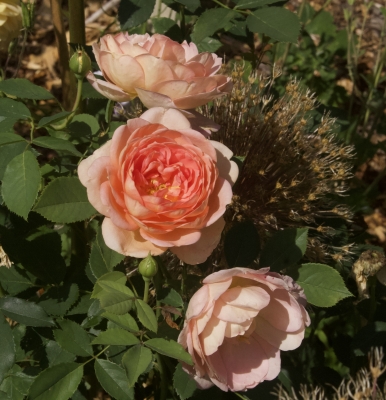
Lady of Shallot rose
David Austin roses, which have the pastel blooms and blowsy form of yesteryear’s roses, and the pest-resistance of present-year roses, are always a draw. But I have quite a few of them; do I have room for or need more of them? It’s cold here (or used to be), so I choose for beauty and hardiness, and, for an added attraction, fragrance. Among my favorites are Lady of Shallot, Dame Judy Dench, Golden Celebration, and LD Braithewaite.
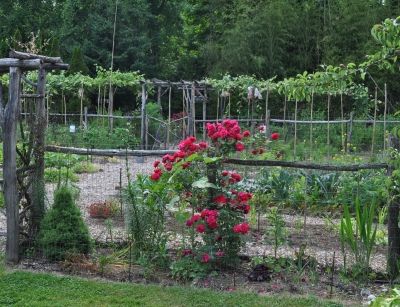
LD Braithwaite Rose
I’ve always wanted to plant a magnolia, of which there are many newer and older varieties, but where could I plant it? My number one choice would be southern magnolia (Magnolia grandiflora), with its large, leathery leaves and also large white, fragrant flowers. Hardier varieties, such as Clara Bogue, could possibly survive here. But mere survival would not let the best of this plant shine. A ragged Southern Magnolia wouldn’t cut it for me.
Years ago I planted a sweetbay magnolia (Magnolia virginiana), a subdued stand in for southern magnolia that I purchased on an impulse at a nursery. The draw for this plant was its semi-evergreen leaves, admittedly, along with its flowers, not as spectacular as southern magnolia. But it was hardy. Allegedly. It succumbed to its first cold winter.
Insects and diseases have decimated my efforts at growing plums. Typically, I throw my hands up and abandon plums for awhile, then realize how good a truly ripe plum can taste, and try again. Obilinya plum is reputedly pest resistant, perhaps warranting a try here. Hmmmm.
And then yesterday I saw mention of a truly spectacular species of mountainash, Sorbus splendens. It’s so new, it doesn’t even have a common name — yet. Also so new that I can’t find any source for seeds or plants. All this perhaps just doubles my lust for it.
It’s hard to keep my wits about me as spring approaches, especially on sunny, less frigid days. “I will not buy another magnolia, I will not buy another magnolia, I will not buy another magnolia, . . .”
Make Room for Pots
Another reason I need to be restrained is because I have some trees and shrubs in pots, waiting in the wings for places to be planted. An Edelweiss grape vine, for example, as well as a fantail willow and an Anwen wisteria plant.
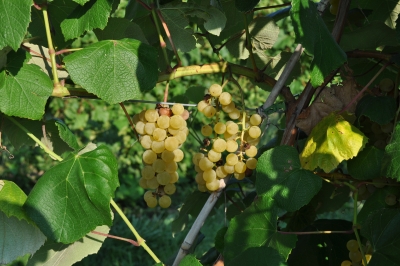
Edelweiss grape
Also shipova, a very rare fruit that I grew many years ago but had to cut down because it was too big for its space. Shipova is one of those rare hybrids that occur between two different genera. One parent is the common, or European, pear, Pyrus communis, and the other parent is probably Sorbus aria, the common whitebeam. The whitebeam parent lends the offspring leaves covered with a downy felt that gives them a snowy appearance, especially on their undersides and early in the season.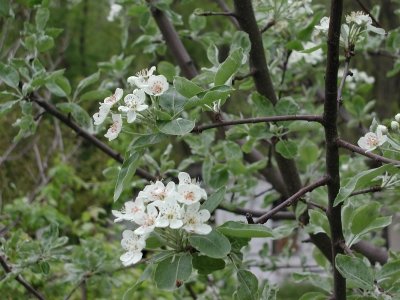
Poor flavor cannot be blamed for shipova’s obscurity. A close flavor comparison would be with pear, although the flesh is just slightly more meaty than a pear, a sweet and fragrant, ambrosia.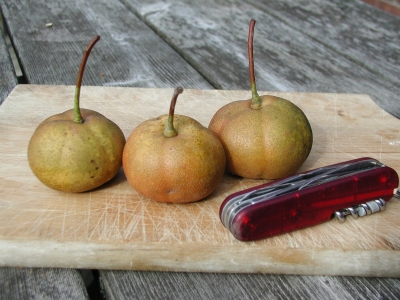
I need to find a space, a large enough space, for the shipova, or else put off any decision and shift the plant to a larger pot.
Potted filberts, also known as hazelnuts, also lie in waiting. The major pest problem of these hybrids of native and European species is eastern filbert blight, which seriously weakens or kills the plants. I’ve planted and dug up and out a number of varieties. Filbert blight fungus is a capricious creature, so over the years I’ve had to rip out of the ground and discard many allegedly disease resistant varieties I had planted, to make room for new varieties.
The plants are very attractive and can be grown as large bushes or small trees. Even now, they’re pretty as their long catkins (male flowers) dangle from the stems waiting to pollinate the female flowers. 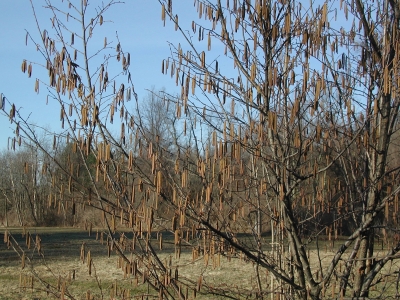 The female flowers go on to become hazelnuts, delicious and usually abundant.
The female flowers go on to become hazelnuts, delicious and usually abundant.
The varieties presently planted seem good as far as disease resistance. Now it’s which ones are best as far as yield, nut size, and flavor. Why not just stick with what I got? Because the potted plants I have will likely prove better. They are Somerset, Monmouth, Raritan, and Hunterdon, all recently named selections from the Rutger’s breeding program.
All this is a reflection, I admit, of some planting sickness. I probably have twice as many filbert trees/bushes as I need.
Hype Immunity
Colorful nursery catalogues and websites notwithstanding, I’m confident , at least, that some “new and wondrous plants” could never entice me, no matter what their hype.
One such plant is a blue rose, which received a lot of press some years ago. A blue rose, in case you didn’t know, is a very big event in gardening. Think about it: Did you ever see a blue rose? No, you didn’t.
This new rose now exists thanks to the wonders of genetic engineering. According to the developer, Suntory of Japan, Applause rose, one of a few blue rose varieties, has a “bluish tinge reminiscent of the sky just after dawn and an elegant, alluring, fresh fragrance.”
Scientists were able to bestow the blue color by inserting into a rose the delphinidin gene, which is also responsible for the blue of delphiniums. The red pigment in roses still causes a problem in not letting the blue fully express itself, but now that the blue gene has been inserted, high hopes exist for even bluer roses in the future.
Call me provincial if you want, but I like red, pink, yellow, or white roses, especially when those colors are pastel rather than harsh. A blue rose seems cold to me. I imagine it exuding a poisonous aroma.
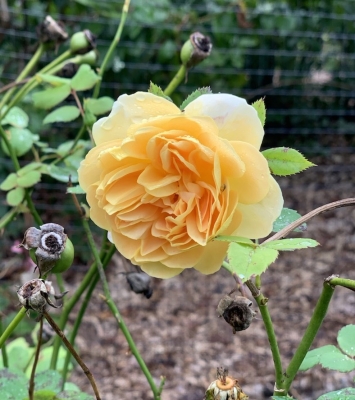
Golden Celebration rose

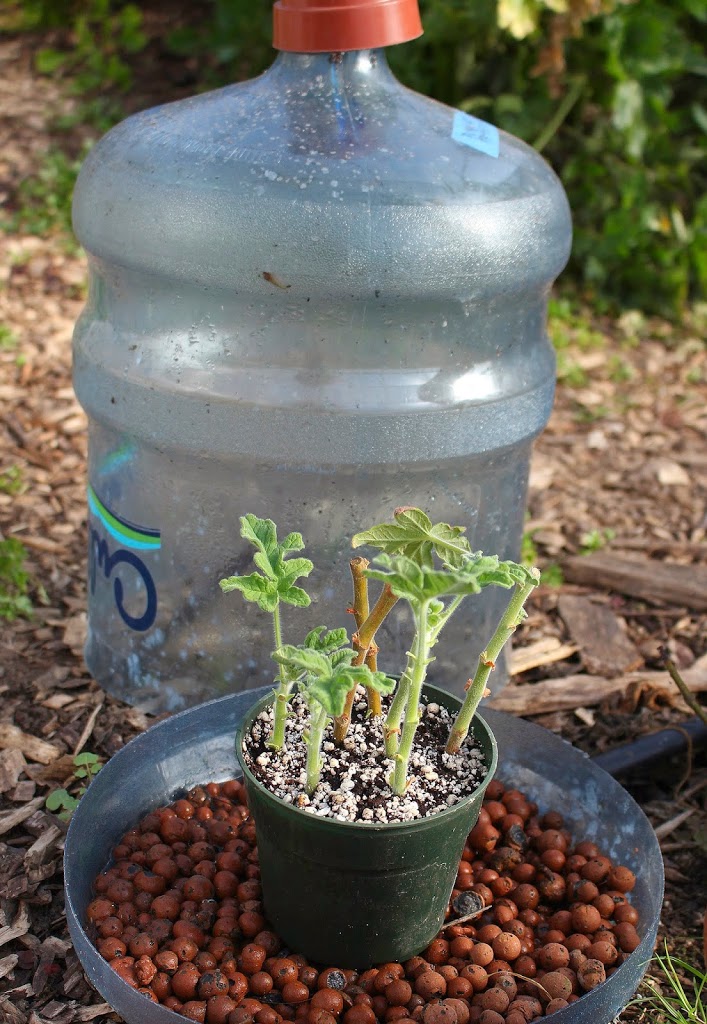

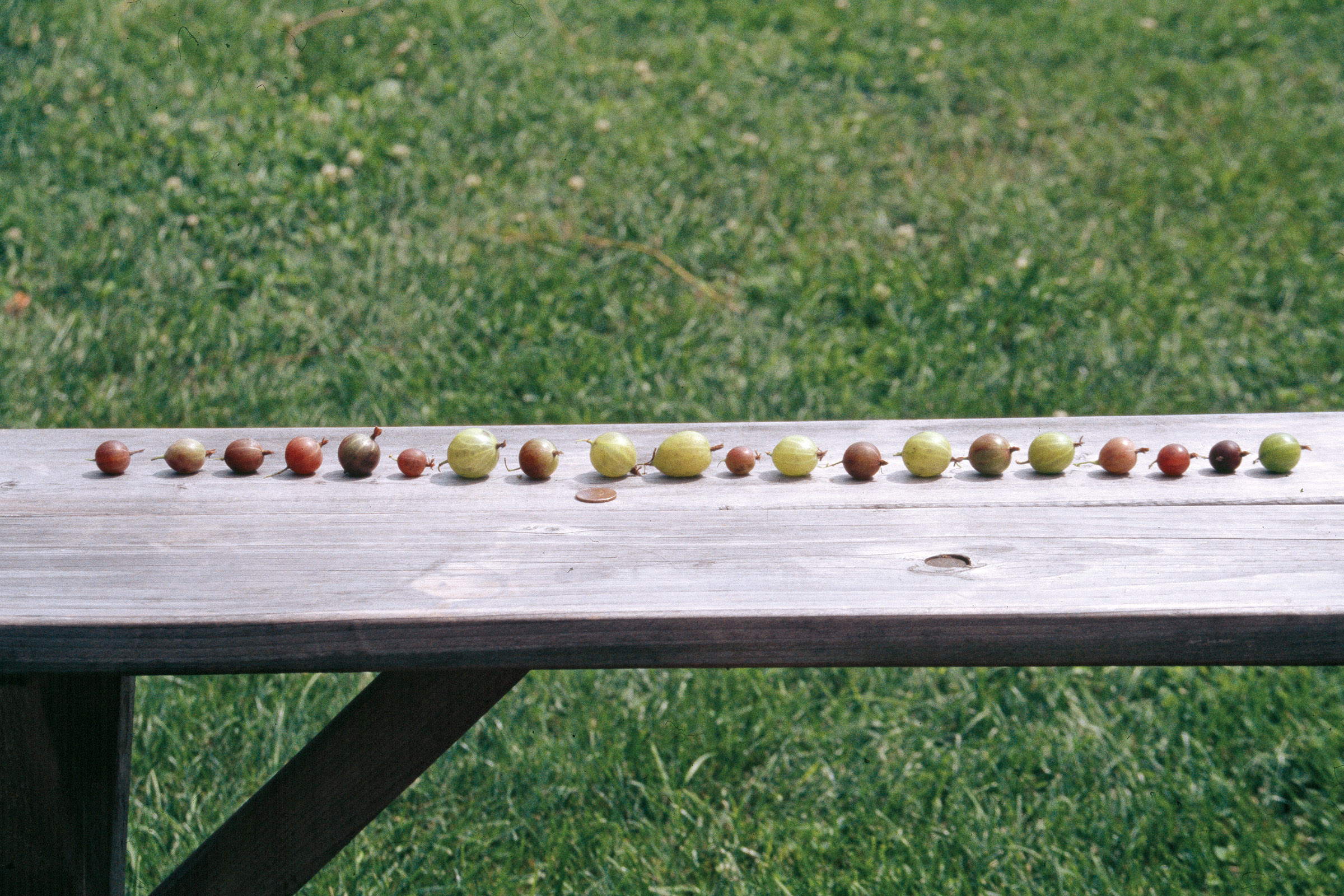
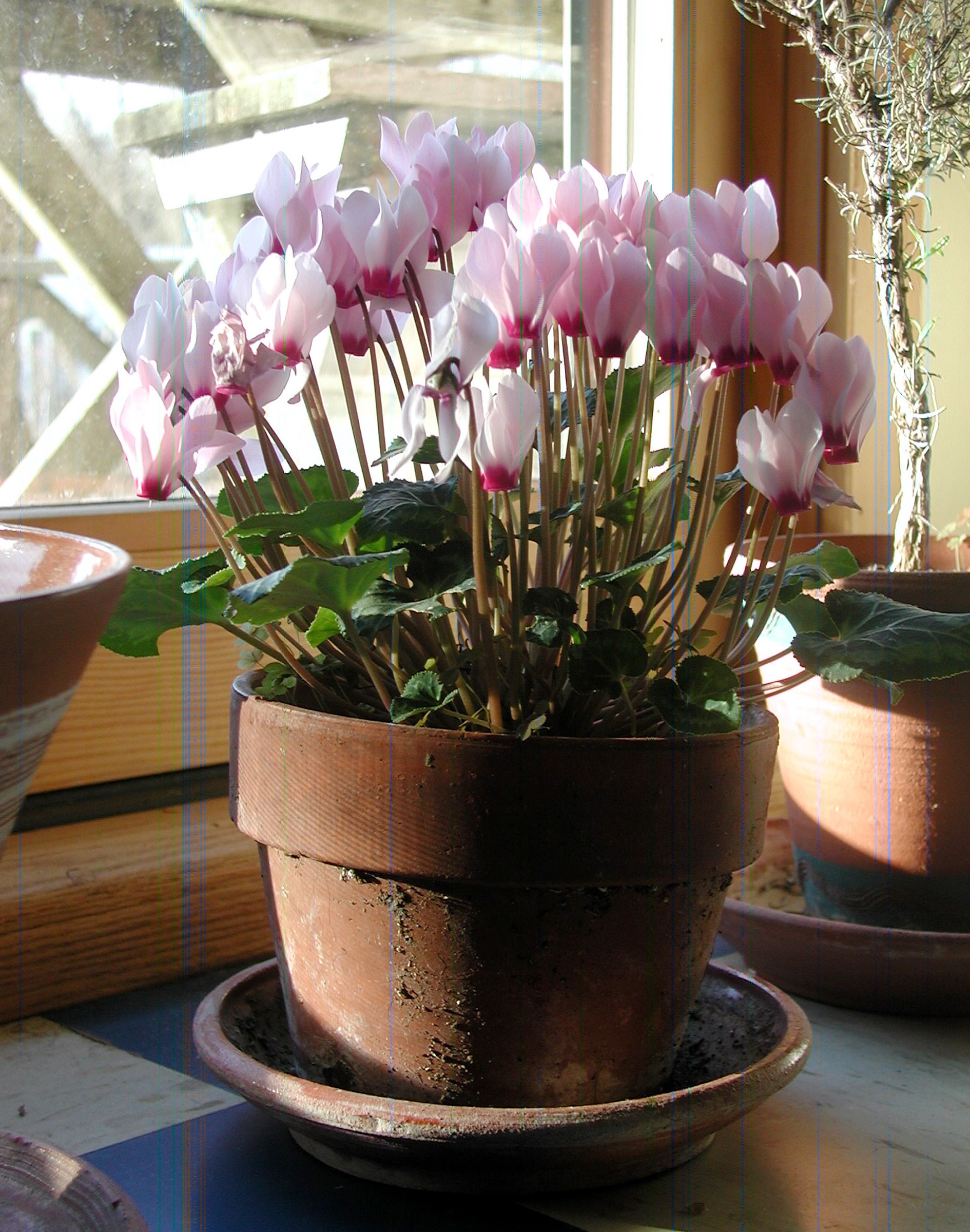
I religiously read your blog posts but I’m struggling with the new design.
How so? Please let me know so that I can talk to the web designer about this. You can reply here or email me via the contact page on my website. Or call. Thanks for the feedback.
Same here. It’s a struggle to read the rather small text against the phantom photo background. The old solid background was much easier on the eyes. I think it was yellow with black text. Nice contrast.
Thanks for your feedback. I’m looking into it.
I have also noticed issues with the new format. When viewed in landscape mode the heading occupies fully the top half of the screen on my tablet, leaving less than 2 inches of text space. The header also jumps or pulls down when scrolling, which is very distracting. Portrait mode works much better, but I prefer to use the tablet held in landscape position.
See if it works better now. Problems with the website were just corrected.
It’s perfect now! Love your blog.
Thank you! Or, rather, thank my web guy.
I’ll weigh in as another regular reader – I mostly read your blog on a phone, and under the new design the column of words appears shifted too far to the right – there’s a wide margin on the left, and the ends of some words are nearly cut off on the right side. Interestingly, I also can no longer make the text bigger/smaller – the size is now fixed. Hope that’s helpful, and look forward to reading about more delectable fruits to try in my garden!
I hope to address these issues today. If not today, very soon. Thanks for alerting me to all this.
Years ago i purchased one of your books: Uncommon Fruits and it has been an inspiration to me. Being in Georgia I can grow things others can only dream about. That is until this last winter’s hard freeze which did some plant damage.
Try again. You probably won’t get that hard freeze every year.
Searching for the search function. I will often search your blog history for specific topics that I recall you addressing, and just realized today that the search function seems to be gone! I’m hoping that this was an oversight in the design revamp and not a conscious decision.
The search function is now much easier to find; it’s on the right side of the green band above the blog post.
You will get clear details from the TREES AND SHRUBS AND VINES. I really loved it and thank you very much for sharing this with us. You have a great visualization and you have really presented this content in a really good manner.
It really helped when you said that a bigger space is needed for Shipova which is why you would need to move it to a larger pot. I wonder what plants I can actually get for the nursery I want to have in my backyard, especially when I want to have fruits growing as well. So I would let professional gardeners do the job for me to ensure that the choices I will make will be successful in the future.